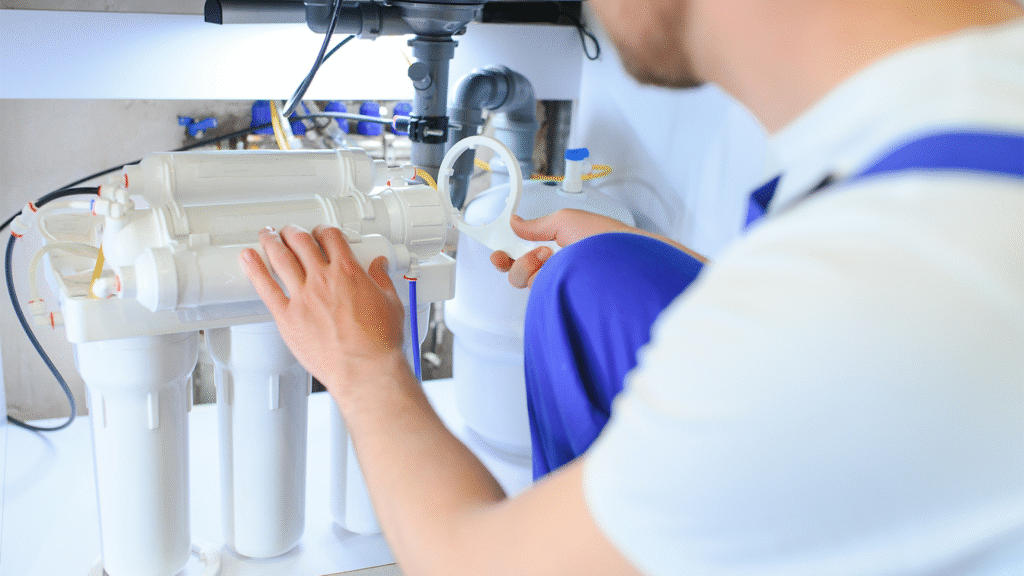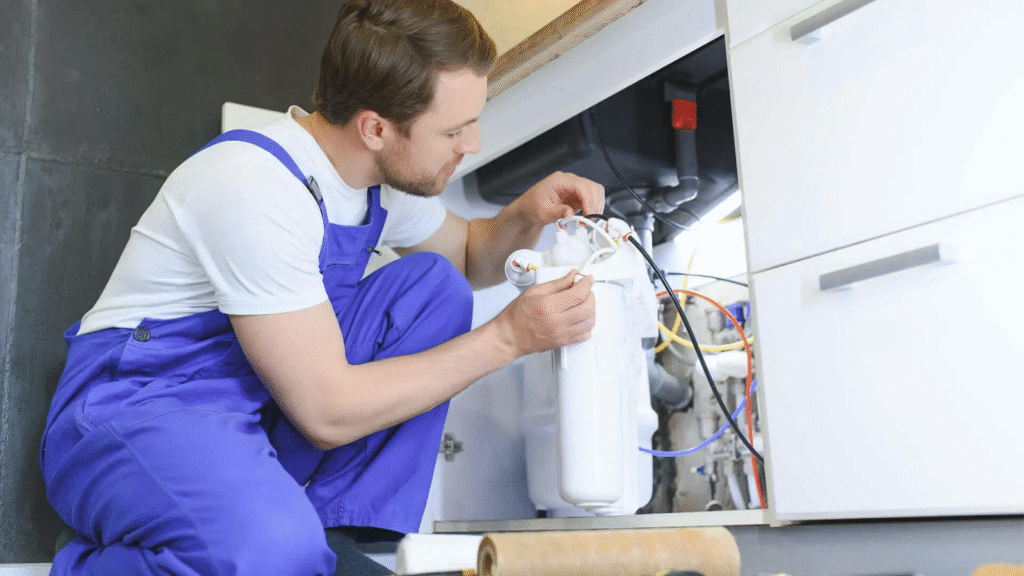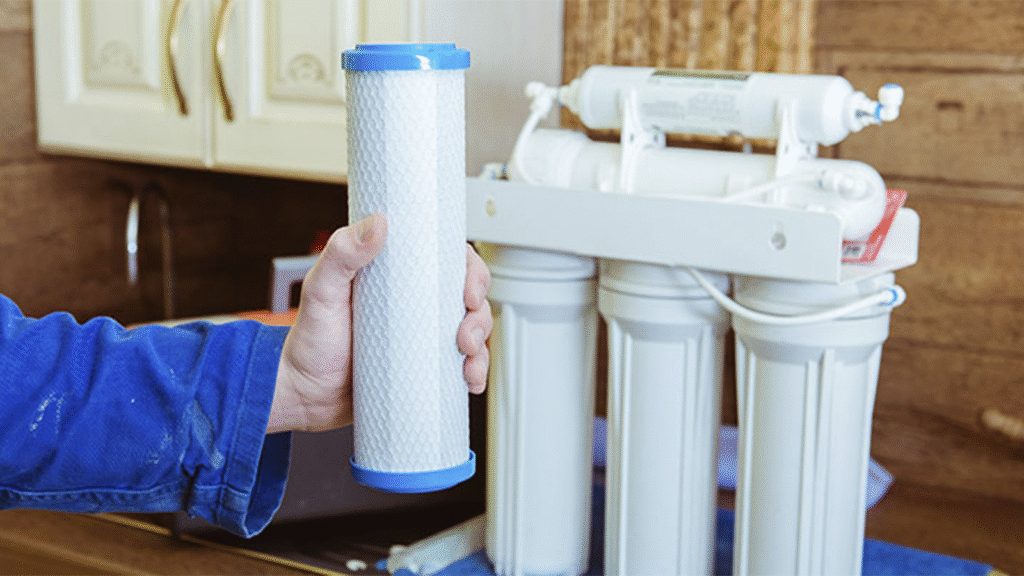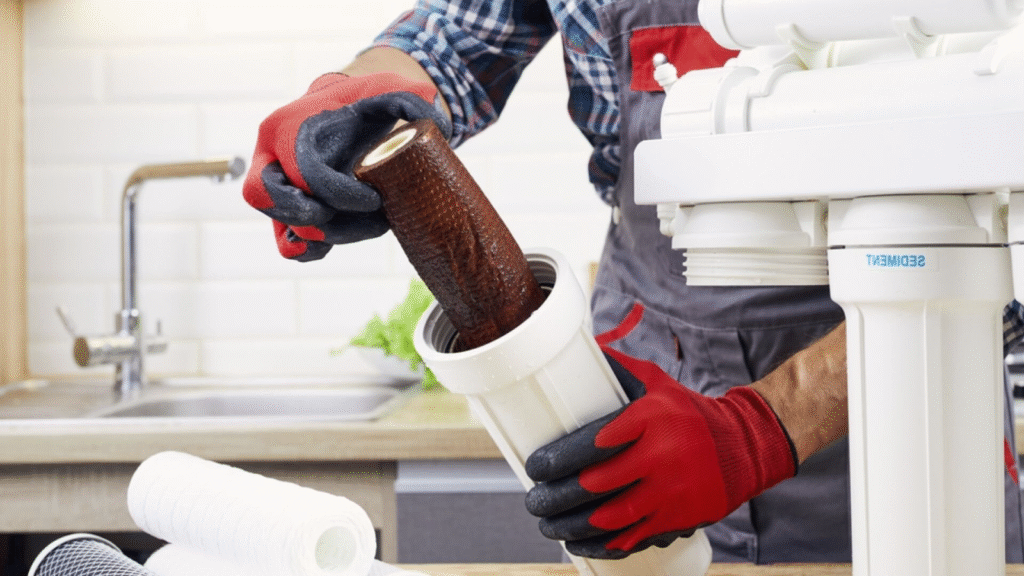Table of Contents
ToggleWhy Edmonton Winters Can Make or Break Your Water Softener Setup
If you’ve ever stood outside on a -25°C morning in Edmonton, waiting for your car to warm up, you know our winters don’t mess around. The frigid air, frozen driveways, and iced-over basements are all part of life here. But there’s one place you don’t want to see frozen: your plumbing.
That’s why winter installation of water softeners in Edmonton requires far more than just technical know-how; it takes strategy, insulation, and awareness of how the cold interacts with your home’s water system.
The stakes are high. A poorly timed or poorly executed winter installation can result in cracked valves, frozen pipes, flooded basements, or a brand-new softener that fails before it ever softens a drop.
But winter doesn’t have to be off-limits for water softener upgrades. In fact, with the right precautions, and by following a solid Edmonton water softener installation guide, it can be the smartest time to do it.
What Makes Winter Installs Different? (It’s Not Just the Cold)
You might think the only issue with winter installations is keeping warm during the job, but in Edmonton, there’s more going on beneath the surface.
Pressure Changes
Cold water contracts, causing higher pressure in lines. If not managed during installation, this can damage seals or misalign fittings.
Harder Access
Exterior taps are often shut off. The garages are unheated. Basement access may be restricted by snow or frozen soil if trenching is needed.
Water Heater Shock
When cold water mixes with residual hot water during cut-ins, pressure shock can crack heater tanks or internal check valves, especially in older models.
Condensation & Humidity Fluctuations
Heating cold pipes rapidly can cause condensation and sweat on valves, risking corrosion if left untreated.
Expansion of Salt Bridges
Improperly filled brine tanks in fluctuating temperatures can harden, leading to salt bridging, a common issue in cold setups.
Risks of Installing in Cold Weather If You’re Not Careful
Installing a water softener during the colder months isn’t wrong, it just demands more caution. These are the top risks Edmonton homeowners face:
1. Frozen Supply Lines
Unheated utility rooms or garages can expose softener lines to freezing temperatures. A frozen feed line can burst once thawed, flooding your home.
2. Cracked Valve Heads
Valve bodies made from certain plastics (especially in budget models) can crack under expansion if exposed to sub-zero air during installation.
3. Air Gap Freezing
Brine discharge lines must legally drain via an air gap. If this gap is near an unheated drain or sump, ice can form, leading to backup and overflow.
4. Delayed Regeneration or Malfunctions
Cold water reduces resin efficiency. If your system isn’t properly programmed for winter conditions, regeneration may be less effective.
5. Installation Adhesives or Sealants Failing
Some plumbers’ putties, caulks, or epoxies don’t bond properly in low temperatures, leading to slow leaks or brittle seals.
Essential Pre-Install Planning for Winter Setups
Before installation begins, here’s what needs to be evaluated in an Edmonton home during winter:
Insulation Check
- Is the installation area fully insulated?
- Are pipe sleeves or heat wraps needed for exposed sections?
- Is there a consistent heat source?
Drain Access
- Can brine discharge reach a drain with adequate slope and stay ice-free?
- If draining to a sump, is it in a heated space?
Electrical Access
- Is the outlet dry and above floor level?
- Does it share a circuit with other major appliances?
Bypass Strategy
- Is there a working bypass valve in case the softener needs emergency deactivation?
Pro Tip: Ask your installer if they use freeze-resistant tubing for winter jobs—it’s worth the small upgrade. If you’re debating whether to hire a pro or go it alone, check out our guide to hiring a plumber for water softener installation to help you choose confidently.
Top Installer-Approved Tips for Winter Installation Success
These insights come straight from seasoned Edmonton installers who’ve handled water softener setups in snowstorms, deep freezes, and more.
Schedule Midday Installs
Avoid early morning or late-day jobs when temperatures are lowest. Midday warmth reduces pipe stress and minimizes the risk of condensation.
Use Heat Tape on Vulnerable Sections
If any pipe, drain line, or overflow tube runs near a garage wall or exterior point, insulate it with thermostat-controlled heat tape.
Prime and Regenerate Indoors
Ensure the system’s first regeneration cycle happens when home temperatures are stable. Avoid overnight cold snaps for this step.
Add a Drain Line Heater if Needed
A tiny heat strip around the drain line near the air gap can keep it ice-free and compliant with city code.
Pre-Warm the Valve
If the unit has been stored in a cold garage or delivery van, bring it indoors for at least 12 hours before connecting to live water.

Cold-Weather Installation Q&A: What Homeowners Ask the Most
Can I install a water softener in my garage in Edmonton?
Yes, but only if it’s insulated and consistently heated. Most garages drop below freezing, even when attached, unless specifically designed to hold HVAC.
Will my warranty cover freeze damage?
No. Most warranties explicitly state that freeze-related cracks or line bursts void coverage.
Should I wait until spring to install it?
Not necessarily. If your water is damaging appliances or causing buildup, waiting means more long-term costs. With precautions, winter installs are safe.
What temperature is too cold for installation?
Most pros recommend not installing if the ambient temperature near the pipes is below 5°C (41°F). If it’s colder, use pipe insulation and heat sources.
Checklist: Do This Before and After a Winter Water Softener Install
If you’re planning to handle part of the setup yourself, don’t miss our DIY water softener installation tips for Edmonton residents, which cover local-specific challenges and practical advice.
Pre-Installation Prep
- Confirm the water line entry location
- Check for exposed pipe sections near cold walls
- Test outlet for ground fault (GFCI)
- Ensure drain access is dry and thawed
- Warm softener and valve parts indoors before setup
During Installation
- Cut pipes slowly to avoid cracking brittle plastics
- Use winter-approved sealant or thread tape
- Install overflow drain line with angle and gap
- Secure brine tank against wall if floor condensation is present
Post-Installation
- Check brine fill and avoid overpacking salt
- Run a test regeneration and monitor discharge
- Watch for leaks or frost overnight
- Set reminders for monthly salt level checks
- Keep heat consistent in the installation area
Print this checklist and give it to your installer, or follow it step by step if you’re doing a hybrid DIY-assisted install.
What If Something Goes Wrong? Emergency Scenarios and Fixes
Even with planning, winter comes with surprises. Here’s how to handle the most common issues:
Frozen Brine Line
- Turn off softener
- Wrap the affected line in warm towels, do not open the flame
- Use a space heater for indirect warming
Overflow at Air Gap
- Check drain for ice blockage
- Clear discharge with boiling water
- Consider rerouting to the sump with a heater strip
Cracked Valve Head
- Immediately shut off the bypass
- Drain the system and call the installer
- File for warranty only if the damage isn’t freeze-related
Why It’s Smart to Install in Winter (If You Do It Right)
While it sounds counterintuitive, winter installation of water softeners in Edmonton can offer some advantages.
Lower Demand for Installers
Winter is considered off-season for many plumbing services, meaning faster booking times and potential seasonal discounts.
Cleaner Testing Conditions
With consistent water use (no outdoor hose taps running), winter testing allows for more accurate system calibration.
Winter Setup = Year-Round Function
By installing in winter, your softener’s first regeneration cycles happen during the most demanding season, ensuring it’s ready for all conditions.
Final Words: Peace of Mind Starts with Smart Precautions
The truth is, you can install a water softener in Edmonton during the winter. It just requires a few more questions, a bit more prep, and a lot more insulation.
Choosing the right installer, or following the right process, can mean the difference between a system that softens flawlessly and one that leaks, cracks, or stalls out by spring.
So whether you’re protecting your appliances, extending your water heater’s life, or just tired of dry winter skin, remember this:
Winter installation of water softeners in Edmonton is entirely feasible, provided you do it correctly.
Need a trusted local installer who knows how to protect your system from Edmonton’s deep freeze?
Water Softener Edmonton offers winter-compliant setup, insulated line routing, and post-install support for your peace of mind.
Book your free winter installation consultation today.



